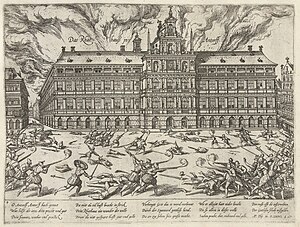Spanish Fury at Antwerp
| Sack of Antwerp | |||||||
|---|---|---|---|---|---|---|---|
| Part of the Eighty Years' War | |||||||
 Mutinous troops of the Army of Flanders ransack the Grote Markt during the Sack of Antwerp, in a Dutch engraving of 1576 by Franc Hogenburg. |
|||||||
|
|||||||
| Belligerents | |||||||
|
|
German and Walloon troops |
||||||
| Commanders and leaders | |||||||
|
|
Count Erberstein † Governor Compagny Marquis d’Havré |
||||||
| Strength | |||||||
| 6,000 | 20,000 (civilians included) | ||||||
| Casualties and losses | |||||||
| very light (possibly 14) | 7,000–18,000 | ||||||
The Sack of Antwerp, often known as the Spanish Fury at Antwerp, was an episode of the Eighty Years' War. It is the greatest massacre in Belgian history.
On 4 November 1576, mutinying Spanish tercios began the sack of Antwerp, leading to three days of horror among the population of the city, which was the cultural, economic and financial center of the Netherlands. The savagery of the sack led the provinces of the Low Countries to unite against the Spanish crown. The devastation also caused Antwerp's decline as the leading city in the region and paved the way for Amsterdam's rise.
The principal cause of the sack was the delay in payment due to the soldiers by Philip II. Spain had recently declared bankruptcy, and 400,000 florins intended as payment to the troops were seized by the government of Elizabeth I when ships containing the florins sought shelter from a storm in English ports.
The Spanish soldiers, angry at fighting without rest or pay against the Dutch rebels, had already sacked Zierikzee and Aalst, causing the fifteen loyal provinces (Holland and Zeeland were in the hands of the rebels) to come together in States-General with the purpose of removing the mercenaries from the Netherlands. It was common procedure with the soldiery at that time, and their procedure was invariable. Without breaking their celebrated discipline, they would choose a new leader, or Eletto, from their number, and march in perfect order under him to whatever their target was. In this instance the Spanish soldiers decided to find for themselves their belated pay, by looting Antwerp.
The idea to sack Antwerp came from the Spanish commander of the Citadel of Antwerp, Sancho d'Avila. He tried to convince the commander of the German troops in the city, Count Otto IV van Eberstein, son of William IV of Eberstein, to deliver the city to the Spanish.
...
Wikipedia
